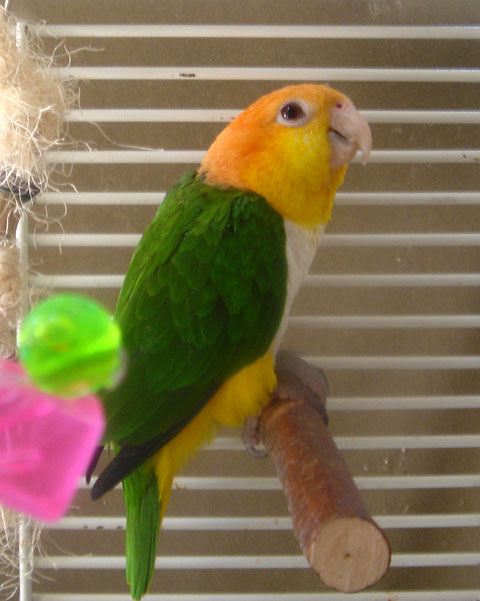Now that you are the proud owner of a Caique, the next step is to learn how caique training will benefit you and your new friend. Due to their high intelligence and energy level, training caiques shouldn’t take long.
Experts recommend that training should begin when parrots are young. They exhibit less aggressive behavior when handled and for the Caique, it is important not to mistake biting for beaking. Caiques are beaky at a young age and, just like a baby, tend to teethe rather than bite.
Before you acquire a Caique, ensure that you have the appropriate steel cage, wooden toys, perches, high-quality pellets, fruits, vegetables, a water bowl, and other necessities. Give them time to settle in and get used to their new home.

Allow the Caique time to explore. Although having a caique in the house is equivalent to having a one-ring-circus. So take them out of the cage (remember, the Caique likes to hop and jump rather than fly) and show him around the house.
Be careful, though, most Caiques love to nestle in your hair and may even pull out some strands. If the Caique should tire (which is doubtful, as they have loads of energy) place them back into the cage. Be warned! They will throw a temper tantrum.
Talk to the bird, although it may not mimic many human sounds, depending on the species it may chatter or toot like a horn. Mostly they imitate sounds coming from the environment. While they are known to have a loud shriek, it shouldn’t pose any problem at the outset.
Caiques need lots of attention. They love to show off, clown around, and examine new things.
They also may exhibit odd behavior from time to time, but not to worry – it’s in their nature. This is the time to bond with the Caique. Unlike other parrot species, he will not cling to just one person in the household but will love anyone who shows him love, kindness, and respect.
Caique Training Info
After a while, you will be able to train your new Caique how to go to the potty, train him to fetch, perhaps talk a bit, definitely sing a happy tune, and enjoy some quiet time as well.
Positive reinforcement is a key element in Training Caiques. In this way, you can reward the Caique for good behavior by bestowing praise, and, conversely, when praise is not given, the parrot will begin to understand that the behavior was ill-advised. If you want to train the Caique, the best way to do so is to ignore him when he does whatever you’re trying to teach him not to do.
Here’s an example: Let’s say the Caique is shrieking for an hour or more. If you try to reprimand the parrot, he will think you are praising him as any attention is better than no attention. Thus, if you say nothing – he will get the idea soon enough. Negative reinforcement will simply result in bad habits and behaviors you will have to retrain.
One can use the baby analogy. When a baby cries and you go into their room to soothe him; the crying stops. Once you step out of the room, the baby starts crying again. If you continue to respond to the baby each and every time they cry, he soon learns that crying is the way to get your attention.
It’s the same with a parrot – any negative behaviors like biting, screaming, or aggression, which can pop up during maturity, are best dealt with immediately so bad habits don’t form. It’s important to condition the parrot from the outset.
As for the actual training, experts recommend a short time frame for teaching. Overtraining can result in a stubborn and disinterested Caique. If the parrot understands what he is asked to do, this part of the training can last for two minutes. Remember to offer praise after he has completed the task.
Taking the time to understand and research the Caique species adds a great deal of knowledge that will allow you to train the parrot effectively. More importantly, however, is for you to devote as much attention as possible to the Caique. Training Caiques is a great way to devote the time they need. They crave attention and your time with them will be greatly rewarded.
